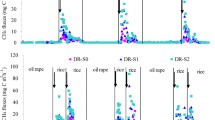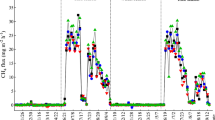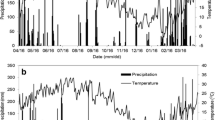Abstract
Machine-transplanted rice with side-deep fertilization (MRSF) can partially compensate for the negative environmental impacts of traditional rice cultivation methods. However, its effects on net ecosystem economic benefit, greenhouse gas emissions, and carbon footprint have not been extensively assessed. We conducted a two-season field experiment to investigate the effects of MRSF in paddy fields on greenhouse gas emissions, global warming potential, carbon footprint, grain yield, and net ecosystem economic benefit. Six treatments with different N application rates (0/0, 90/99, 105/116, 120/132, 135/149, and 150/165 kg N ha−1) were applied to early season rice and late-season rice. The results indicated that under MRSF, soil CH4 and N2O emissions were significantly lower (by 13.2–45.6% and 5.4–28.7% in early season rice and 21.3–42.3% and 19.1–35.6% in late-season rice, respectively) than those under conventional fertilization. Chemical fertilizer was the largest contributor to greenhouse gas emissions from agricultural inputs for the early season and late-season rice. Additionally, MRSF mitigated soil CH4 and N2O emissions and ultimately reduced the total greenhouse gas emissions. The net ecosystem economic benefit of MRSF was significantly higher (by 16.3–25.7% and 23.4–29.7% for the early season and late-season rice, respectively) than that under conventional fertilization. Overall, MRSF is an economically beneficial approach with low environmental impact for commercial rice cultivation.






Similar content being viewed by others
References
Aliyu G, Luo J, Di HJ, Lindsey S, Liu D, Yuan J, Chen Z, Lin Y, He T, Zaman M, Ding W (2019) Nitrous oxide emissions from China’s croplands based on regional and crop-specific emission factors deviate from IPCC 2006 estimates. Sci Total Environ 669:547–558. https://doi.org/10.1016/j.scitotenv.2019.03.142
Bai J, Li Y, Zhang J, Xu F, Bo Q, Wang Z, Li Z, Li S, Shen Y, Yue S (2021) Straw returning and one-time application of a mixture of controlled release and solid granular urea to reduce carbon footprint of plastic film mulching spring maize. J Clean Prod 280:124478. https://doi.org/10.1016/j.jclepro.2020.124478
Bandaogo A, Bidjokazo F, Youl S, Safo E, Abaidoo R, Andrews O (2014) Effect of fertilizer deep placement with urea supergranule on nitrogen use efficiency in Sourou Valley (Burkina Faso). Nutr Cycl Agroecosyst 102:79–89. https://doi.org/10.1007/s10705-014-9653-6
Banger K, Tian H, Lu C (2012) Do nitrogen fertilizers stimulate or inhibit methane emissions from rice fields? Glob Chang Biol 18:3259–3267. https://doi.org/10.1111/j.1365-2486.2012.02762.x
Butterbach-Bahl K, Baggs EM, Dannenmann M, Kiese R, Zechmeister-Boltenstern S (2013) Nitrous oxide emissions from soils: how well do we understand the processes and their controls? Philos Trans R Soc Lond B Biol Sci 368:20130122. https://doi.org/10.1098/rstb.2013.0122
Cai S, Pittelkow CM, Zhao X, Wang S (2018) Winter legume-rice rotations can reduce nitrogen pollution and carbon footprint while maintaining net ecosystem economic benefits. J Clean Prod 195:289–300. https://doi.org/10.1016/j.jclepro.2018.05.115
Chen XP, Cui ZL, Fan MS, Vitousek P, Zhao M, Ma WQ et al (2014) Producing more grain with lower environmental costs. Nature 514:486–489. https://doi.org/10.1038/nature13609
Chen Q, He A, Wang W, Peng S, Huang J, Cui K, Nie L (2018) Comparisons of regeneration rate and yields performance between inbred and hybrid rice cultivars in a direct seeding rice–ratoon rice system in central China. Field Crops Res 223:164–170. https://doi.org/10.1016/j.fcr.2018.04.010
Fang K, Gao H, Sha Z, Dai W, Yi X, Chen H, Cao L (2021) Mitigating global warming potential with increase net ecosystem economic budget by integrated rice-frog farming in eastern China. Agric Ecosyst Environ 308:107235. https://doi.org/10.1016/j.agee.2020.107235
FAO (2017) Food and Agriculture Data 2017: production and Emissions in the World [DB/OL]. http://www.fao.org
Gaihre YK, Singh U, Islam SMM, Huda A, Islam MR, Satter MA, Sanabria J, Islam MR, Shah AL (2015) Impacts of urea deep placement on nitrous oxide and nitric oxide emissions from rice fields in Bangladesh. Geoderma 259–260:370–379. https://doi.org/10.1016/j.geoderma.2015.06.001
Gan YT, Liang C, Chai Q, Lemke RL, Campbell CA, Zentner RP (2014) Improving farming practices reduces the carbon footprint of spring wheat production. Nat Commun 5:5012. https://doi.org/10.1038/ncomms6012
Gilbert B, Frenzel P (1998) Rice roots and CH4 oxidation: the activity of bacteria, their distribution and the microenvironment. Soil Biol Biochem 30:1903–1916. https://doi.org/10.1016/S0038-0717(98)00061-3
Hillier J, Hawes C, Squire G, Hilton A, Wale S, Smith P (2009) The carbon footprints of food crop production. Int J Agric Sustain 7:107–118. https://doi.org/10.3763/ijas.2009.0419
Hou H, Peng S, Xu J, Yang S, Mao Z (2012) Seasonal variations of CH4 and N2O emissions in response to water management of paddy fields located in Southeast China. Chemosphere 89:884–892. https://doi.org/10.1016/j.chemosphere.2012.04.066
Hu XK, Su F, Ju XT, Gao B, Oenema O, Christie P, Huang BX, Jiang RF, Zhang FS (2013) Greenhouse gas emissions from a wheat–maize double cropping system with different nitrogen fertilization regimes. Environ Pollut 176:198–207. https://doi.org/10.1016/j.envpol.2013.01.040
Hu AY, Sun X, Liu Q (2016) Effects of different rotation systems on greenhouse gas (CH4 and N2O) emissions in the Taihu Lake region, China. Chin J Appl Ecol 27:99–106. https://doi.org/10.13287/j.1001-9332.201601.031
Huda A, Gaihre YK, Islam MR, Singh U, Islam MR, Sanabria J, Satter MA, Afroz H, Halder A, Jahiruddin M (2016) Floodwater ammonium, nitrogen use efficiency and rice yields with fertilizer deep placement and alternate wetting and drying under triple rice cropping systems. Nutr Cycl Agroecosyst 104:53–66. https://doi.org/10.1007/s10705-015-9758-6
IPCC (2013) The physical science basis. Contribution of working group I to the fifth assessment report of the Intergovernmental Panel on Climate Change Climate change 2013 the physical science basis. Summary for policymakers. Clim Change. Cambridge University Press, Cambridge
IPCC (2014) Climate change 2014—mitigation of climate change: working group I contribution to the fourth assessment report of the IPCC. Cambridge University Press, Cambridge
IPCC (Intergovernmental Panel on Climate Change) (2019) Climate change and land: an IPCC special report on climate change, desertifification, land degradation, sustainable land management, food security, and greenhouse gas fluxes in terrestrial ecosystems
ISO 14067 (2013) Greenhouse gases e carbon footprint of products e requirements and guidelines for quantification and communication. Geneva, Switzerland, pp 1
Jiang Z, Zhong Y, Yang J, Wu Y, Li H, Zheng L (2019) Effect of nitrogen fertilizer rates on carbon footprint and ecosystem service of carbon sequestration in rice production. Sci Total Environ 670:210–217. https://doi.org/10.1016/j.scitotenv.2019.03.188
Kargbo MB, Pan SG, Mo ZW, Wang ZM, Luo XW, Tian H, Hossain MF, Ashraf U, Tang X (2016) Physiological basis of improved performance of super rice (Oryza sativa) to deep placed fertilizer with precision hill-drilling machine. Int J Agric Biol 18:797–804. https://doi.org/10.17957/IJAB/15.0173
Kim SY, Gutierrez J, Kim PJ (2012) Considering winter cover crop selection as green manure to control methane emission during rice cultivation in paddy soil. Agric Ecosyst Environ 161:130–136. https://doi.org/10.1016/j.agee.2012.07.026
Li B, Fan CH, Zhang H, Chen ZZ, Sun LY, Xiong ZQ (2015) Combined effects of nitrogen fertilization and biochar on the net global warming potential, greenhouse gas intensity and net ecosystem economic budget in intensive vegetable agriculture in southeastern China. Atmos Environ 100:10–19. https://doi.org/10.1016/j.atmosenv.2014.10.034
Li SH, Guo LJ, Cao CG, Li CF (2021) Effects of straw returning levels on carbon footprint and net ecosystem economic benefits from rice-wheat rotation in central China. Environ Sci Pollut Res Int 28:5742–5754. https://doi.org/10.1007/s11356-020-10914-w
Liang XQ, Li H, Wang SX, Ye YS, Ji YJ, Tian GM, van Kessel C, Linquist BA (2013) Nitrogen management to reduce yield-scaled global warming potential in rice. Field Crops Res 146:66–74. https://doi.org/10.1016/j.fcr.2013.03.002
Liang K, Zhong X, Huang N, Lampayan RM, Liu Y, Pan J, Fu Y (2017) Nitrogen losses and greenhouse gas emissions under different N and water management in a subtropical double-season rice cropping system. Sci Total Environ 609:46–57. https://doi.org/10.1016/j.scitotenv.2017.07.118
Linquist BA, Adviento-Borbe MA, Pittelkow CM, van Kessel C, van Groenigen KJ (2012a) Fertilizer management practices and greenhouse gas emissions from rice systems: a quantitative review and analysis. Field Crops Res 135:10–21. https://doi.org/10.1016/j.fcr.2012.06.007
Linquist B, Groenigen KJ, Adviento-Borbe MA, Pittelkow C, Kessel C (2012b) An agronomic assessment of greenhouse gas emissions from major cereal crops. Glob Chang Biol 18:194–209. https://doi.org/10.1111/j.1365-2486.2011.02502.x
Liu M, Dannenmann M, Lin S, Saiz G, Yan G, Yao Z, Pelster DE, Tao H, Sippel S, Tao Y, Zhang Y, Zheng X, Zuo Q, Butterbach-Bahl K (2015) Ground cover rice production systems increase soil carbon and nitrogen stocks at regional scale. Biogeosciences 12:4831–4840. https://doi.org/10.5194/bg-12-4831-2015
Liu W, Zhang G, Wang X, Lu F, Ouyang Z (2018) Carbon footprint of main crop production in China: magnitude, spatial-temporal pattern and attribution. Sci Total Environ 645:1296–1308. https://doi.org/10.1016/j.scitotenv.2018.07.104
Liu TQ, Li SH, Guo LG, Cao CG, Li CF, Zhai ZB, Zhou JY, Mei YM, Ke HJ (2020) Advantages of nitrogen fertilizer deep placement in greenhouse gas emissions and net ecosystem economic benefits from no-tillage paddy fields. J Clean Prod. https://doi.org/10.1016/j.jclepro.2020.121322
Lynch J, Cain M, Pierrehumbert R, Allen M (2020) Demonstrating GWP*: a means of reporting warming-equivalent emissions that captures the contrasting impacts of short- and long-lived climate pollutants. Environ Res Lett 15:044023. https://doi.org/10.1088/1748-9326/ab6d7e
Min J, Sun H, Wang Y, Pan Y, Kronzucker HJ, Zhao D, Shi W (2021) Mechanical side-deep fertilization mitigates ammonia volatilization and nitrogen runoff and increases profitability in rice production independent of fertilizer type and split ratio. J Clean Prod 316:128370. https://doi.org/10.1016/j.jclepro.2021.128370
Raheem A, Zhang J, Huang J, Jiang Y, Siddik MA, Deng A, Gao JS, Zhang W (2019) Greenhouse gas emissions from a rice-rice-green manure cropping system in South China. Geoderma 353:331–339. https://doi.org/10.1016/j.geoderma.2019.07.007
Rahman S, Barmon BK (2015) Exploring the potential to improve energy saving and energy efficiency using fertilizer deep placement strategy in modern rice production in Bangladesh. Energy Effic 8:1241–1250. https://doi.org/10.1007/s12053-015-9391-x
Recio J, Vallejo A, Le-Noë J, Garnier J, García-Marco S, Álvarez JM, Sanz-Cobena A (2018) The effect of nitrification inhibitors on NH3 and N2O emissions in highly N fertilized irrigated Mediterranean cropping systems. Sci Total Environ 636:427–436. https://doi.org/10.1016/j.scitotenv.2018.04.294
Robertson GP, Grace PR (2004) Greenhouse gas fluxes in tropical and temperate agriculture: the need for a full-cost accounting of global warming potentials. Environ Dev Sustain 6:51–63. https://doi.org/10.1023/B:ENVI.0000003629.32997.9e
Savant NK, Stangel PJ (1990) Deep placement of urea supergranules in transplanted rice: principles and practices. Fert Res 25:1–83. https://doi.org/10.1007/BF01063765
Shang Q, Yang X, Gao C, Wu P, Liu J, Xu Y, Shen Q, Zou J, Guo S (2011) Net annual global warming potential and greenhouse gas intensity in Chinese double rice-cropping systems: a 3-year field measurement in long-term fertilizer experiments. Glob Chang Biol 17:2196–2210. https://doi.org/10.1111/j.1365-2486.2010.02374.x
Shen J, Li C, Mi G, Li L, Yuan L, Jiang R, Zhang F (2013) Maximizing root/rhizosphere efficiency to improve crop productivity and nutrient use efficiency in intensive agriculture of China. J Exp Bot 64:1181–1192. https://doi.org/10.1093/jxb/ers342
Smith P, Haberl H, Popp A, Erb KH, Lauk C, Harper R et al (2013) How much land-based greenhouse gas mitigation can be achieved without compromising food security and environmental goals? Glob Chang Biol 19:2285–2302. https://doi.org/10.1111/gcb.12160
Soil Survey Staff (2010) Keys to soil taxonomy. In: 11th edn. NRCS. United States Department of Agriculture
Sun J, Du T, Sun W, Na H, He J, Qiu Z, Li Y (2019) An evaluation of greenhouse gas emission efficiency in China’s industry based on SFA. Sci Total Environ 690:1190–1202. https://doi.org/10.1016/j.scitotenv.2019.07.093
Wang X, Yamauchi F, Otsuka K, Huang J (2016) Wage growth, landholding, and mechanization in Chinese agriculture. World Dev 86:30–45. https://doi.org/10.1016/j.worlddev.2016.05.002
Xia L, Lam SK, Chen D, Wang J, Tang Q, Yan X (2017) Can knowledge-based N management produce more staple grain with lower greenhouse gas emission and reactive nitrogen pollution? A meta-analysis. Glob Chang Biol 23:1917–1925. https://doi.org/10.1111/gcb.13455
Xue J, Liu S, Chen Z, Chen F, Lal R, Tang H, Zhang H (2014) Assessment of carbon sustainability under different tillage systems in a double rice cropping system in Southern China. Int J Life Cycle Assess 19:1581–1592. https://doi.org/10.1007/s11367-014-0768-4
Xue J, Pu C, Liu S, Zhao X, Zhang R, Chen F, Xiao X, Zhang HL (2016) Carbon and nitrogen footprint of double rice production in Southern China. Ecol Indic 64:249–257. https://doi.org/10.1016/j.ecolind.2016.01.001
Yadav GS, Das A, Lal R, Babu S, Meena RS, Saha P, Singh R, Datta M (2018) Energy budget and carbon footprint in a no-till and mulch based rice-mustard cropping system. J Clean Prod 191:144–157. https://doi.org/10.1016/j.jclepro.2018.04.173
Yao ZS, Zheng XH, Zhang YN, Liu CY, Wang R, Lin S, Zuo Q, Butterbach-Bahl K (2017) Urea deep placement reduces yield-scaled greenhouse gas (CH4 and N2O) and NO emissions from a ground cover rice production system. Sci Rep 7:11415. https://doi.org/10.1038/s41598-017-11772-2
Yao YL, Zeng K, Song YZ (2020) Biological nitrification inhibitor for reducing N2O and NH3 emissions simultaneously under root zone fertilization in a Chinese rice field. Environ Pollut 264:114821. https://doi.org/10.1016/j.envpol.2020.114821
Zhang ZS, Guo LJ, Liu TQ, Li CF, Cao CG (2015) Effects of tillage practices and straw returning methods on greenhouse gas emissions and net ecosystem economic budget in rice-wheat cropping systems in central China. Atmos Environ 122:636–644. https://doi.org/10.1016/j.atmosenv.2015.09.065
Zhao Z, Yue YB, Sha ZM, Li CS, Deng J, Zhang HL, Gao MF, Cao LK (2015) Assessing impacts of alternative fertilizer management practices on both nitrogen loading and greenhouse gas emissions in rice cultivation. Atmos Environ 119:393–401. https://doi.org/10.1016/j.atmosenv.2015.08.060
Zhong Y, Wang X, Yang J, Zhao X, Ye X (2016) Exploring a suitable nitrogen fertilizer rate to reduce greenhouse gas emissions and ensure rice yields in paddy fields. Sci Total Environ 565:420–426. https://doi.org/10.1016/j.scitotenv.2016.04.167
Zhong X, Zhou X, Fei J, Huang Y, Wang G, Kang X, Hu W, Zhang H, Rong X, Peng J (2021) Reducing ammonia volatilization and increasing nitrogen use efficiency in machine-transplanted rice with side-deep fertilization in a double-cropping rice system in Southern China. Agric Ecosyst Environ 306:107183. https://doi.org/10.1016/j.agee.2020.107183
Zhu C, Xiang J, Zhang Y, Zhang Y, Zhu D, Chen H (2019) Mechanized transplanting with side deep fertilization increases yield and nitrogen use efficiency of rice in Eastern China. Sci Rep 9:5653. https://doi.org/10.1038/s41598-019-42039-7
Acknowledgements
This study was supported by the National Key Research and Development Project—the Development and Application of Slow Controlled-release Fertilizer Coating with Polyether Polyurethane (2017YFD200703-3), the National Technical System of Rice Industry (CARS-01-26), the Hunan Innovation Fund of Agricultural Science and Technology (2019LS03-3), and the Hunan Youth Fund of Natural Science Foundation (2019JJ50337).
Author information
Authors and Affiliations
Corresponding authors
Additional information
Publisher's Note
Springer Nature remains neutral with regard to jurisdictional claims in published maps and institutional affiliations.
Supplementary Information
Below is the link to the electronic supplementary material.
Rights and permissions
About this article
Cite this article
Zhong, X., Zhou, X., Fei, J. et al. Gained net ecosystem economic benefit in machine-transplanted double-cropped rice strategies. Nutr Cycl Agroecosyst 124, 1–15 (2022). https://doi.org/10.1007/s10705-022-10218-0
Received:
Accepted:
Published:
Issue Date:
DOI: https://doi.org/10.1007/s10705-022-10218-0




